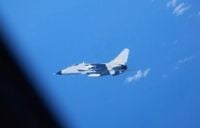Japan has issued a firm demand to China, urging it to halt the increasingly dangerous practice of flying fighter jets alarmingly close to Japanese intelligence-gathering aircraft. This comes after a Chinese JH-7 fighter-bomber reportedly came within just 30 meters (about 98 feet) of a Japan Air Self-Defense Force YS-11EB electronic-intelligence aircraft over the East China Sea on July 9 and 10, 2025, according to Japan's Defense Ministry.
The ministry clarified that these incidents occurred outside Japanese airspace and that no damage was sustained by the Japanese aircraft. Nevertheless, the close proximity of the Chinese jet has raised serious concerns in Tokyo about the risks of accidental collisions, which could escalate tensions between the two nations.
Japan’s Foreign Ministry expressed its alarm late on July 10, with Vice Minister Takehiro Funakoshi conveying "serious concern" directly to Chinese Ambassador Wu Jianghao. In a strong statement, Funakoshi requested that Beijing cease such provocative actions and emphasized the urgent need to prevent any recurrence of these potentially hazardous encounters.
This latest episode is not an isolated one. Just a month earlier, in June 2025, the two countries exchanged accusations over similar close calls. Japan had reported that a Chinese combat aircraft flew extremely close to a Japanese navy P-3C surveillance plane over the Pacific Ocean. Notably, this event coincided with the first known operation of two Chinese aircraft carriers together in the area, marking a significant development in China's military capabilities.
Japan’s concerns extend beyond these aerial incidents to the broader context of China’s accelerated military buildup, especially in regions southwest of Japan. The expansion of Chinese military presence near Japanese territory has heightened anxieties in Tokyo about regional security and the potential for miscalculations that could spiral into conflict.
Despite these military tensions, economic relations between Japan and China appear to be on a cautious upswing. On July 11, 2025, Japan announced the implementation of an animal health and quarantine agreement with China. This agreement is a crucial step toward resuming Japanese beef exports to China, which have been banned since 2001 following an outbreak of mad cow disease in Japan.
The timing of this trade development is particularly notable given the backdrop of strained relations over environmental and safety concerns. Earlier this year, China had imposed a 22-month ban on Japanese seafood imports in response to Japan’s discharge of treated radioactive wastewater from the tsunami-damaged Fukushima nuclear power plant, which began in 2023. However, China partially lifted this ban recently, approving the re-registration of three Japanese seafood exporters, signaling a tentative thaw in trade restrictions.
These contrasting dynamics—military tensions in the skies and warming economic ties on the ground—highlight the complex and often contradictory nature of Sino-Japanese relations. While Tokyo presses Beijing to avoid dangerous military maneuvers that risk accidental collisions, both nations are simultaneously navigating pathways to restore and enhance economic cooperation amid broader geopolitical challenges.
The Japanese government’s insistence on safety and restraint in military encounters underscores a broader strategic imperative to manage regional security risks while maintaining diplomatic channels. As Vice Minister Funakoshi stated, the repeated close encounters "could provoke accidental collisions," a scenario both sides presumably wish to avoid given the potentially severe consequences.
China, for its part, has yet to issue an immediate comment on the most recent incident involving the JH-7 fighter-bomber. Previously, Beijing has accused Japan of flying close to its aircraft and spying on China’s routine military activities, demanding that Japan cease such actions. This tit-for-tat pattern of accusations reflects the deep mistrust that colors their military interactions.
Observers note that the East China Sea and adjoining Pacific waters have become a hotspot for these risky aerial maneuvers, with both countries keen to assert their presence and monitor each other’s activities. The presence of Chinese aircraft carriers operating in tandem near these contested areas adds a new layer of complexity and signals China’s growing naval ambitions.
Meanwhile, the recent progress on trade agreements, such as the animal health and quarantine pact, offers a glimmer of hope that economic pragmatism might help ease tensions. The resumption of Japanese beef exports to China after more than two decades, along with the partial lifting of seafood import bans, could foster a more stable bilateral relationship, provided military provocations do not escalate.
As Japan continues to monitor China’s military expansion closely, the government faces the delicate task of balancing firm diplomatic protests with efforts to maintain constructive economic engagement. The coming months will be telling in how both countries manage these intertwined challenges—avoiding conflict in the skies while building bridges through trade and cooperation on less contentious fronts.
Ultimately, the recent near-miss incidents serve as a stark reminder of the fragile nature of peace in one of the world's most strategically sensitive regions. The call from Japan for China to stop flying dangerously close to its aircraft is not just about preventing accidents—it’s about preserving stability and preventing misunderstandings that could have far-reaching consequences for regional and global security.


